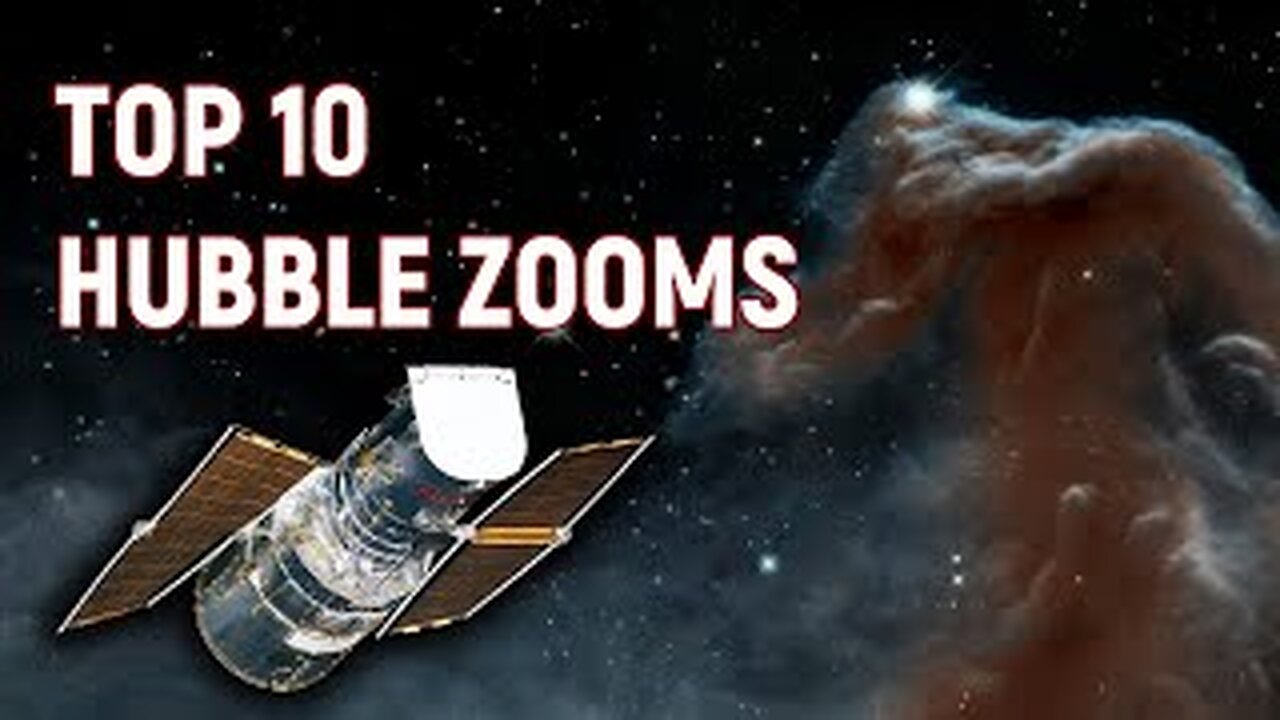Premium Only Content

Top 10 Zooms for the Hubble Space Telescope
00:00 Zooming in on the Andromeda Galaxy. This Hubble image of this galaxy marks the largest release of its kind, revealing over 100 million stars and numerous star clusters nestled within a portion of the galaxy's flat, disc-shaped structure that spans more than 40,000 light-years.
Source: https://esahubble.org/videos/heic1502a/
Credit: NASA, ESA, Digitized Sky Survey 2, N. Risinger (Skysurvey.org), J. Dalcanton (University of Washington, USA), B. F. Williams (University of Washington, USA), L. C. Johnson (University of Washington, USA), the PHAT team, and R. Gendler.
00:50 Zooming in on the crab nebula. This video zooms in on a section of the sky in the Taurus constellation, concluding with a close-up of the inner regions of the renowned Crab Nebula, a remnant of a supernova.
Source: https://esahubble.org/videos/heic1614a/
Credit: ESA/Hubble, Digitized Sky Survey, Nick Risinger
01:40 Zoom into the Pillars of Creation. Transitioning from a ground-based perspective, this video showcases a three-color composite mosaic image of the Eagle Nebula (Messier 16), derived from images obtained with the MPG/ESO 2.2-meter telescope, culminating in a new NASA/ESA Hubble Space Telescope image capturing the Pillars of Creation within the Eagle Nebula.
Source: https://esahubble.org/videos/heic1501f/
Credit: NASA, ESA/Hubble and the Hubble Heritage Team
02:30 Zoom in to the Milky Way Center. Commencing with a view of the Milky Way, this video zooms in on the core of our home galaxy as observed by the NASA/ESA Hubble Space Telescope.
Source: https://esahubble.org/videos/heic1606a/
Credit: Risinger/Guisard/ESO/Hubble
03:20 Zooming in on the Horsehead Nebula. This video provides a close-up of a section of the sky in the Orion constellation, presenting infrared Hubble observations of the Horsehead Nebula (also known as Barnard 33). The video ends with a three-dimensional fly-through of the nebula.
Source: https://esahubble.org/videos/heic1307b/
Credit: NASA, ESA, the Hubble Heritage Team (STScI/AURA); G. Bacon, T. Borders, L. Frattare, Z. Levay, and F. Summers (Viz 3D team, STScI); ESO
04:14 Zooming in on the Triangulum Galaxy. This immersive journey transports the viewer on a three-million-light-year voyage to the Triangulum Galaxy, Messier 33. The final view, captured by the NASA/ESA Hubble Space Telescope, represents the most detailed wide-field observation of this object to date, showcasing the numerous luminous gas clouds in the spiral arms with remarkable clarity.
Source: https://esahubble.org/videos/heic1901b/
Credit: ESA, ESO, DSS, NASA, Risinger
05:04 Zooming into the Bat Shadow and its “flapping”. From the vicinity around the Serpens Nebula to the young star HBC 672, this video reveals the intriguing "flapping" motion observed for the first time in the shadow of the star's disk by the NASA/ESA Hubble Space Telescope. This star, nicknamed Bat Shadow due to its wing-like shadow feature, resides in the Serpens Nebula, approximately 1300 light-years away.
Source: https://esahubble.org/videos/heic2012b/
Credit: ESA/Hubble, Digitized Sky Survey, L. Calçada, Nick Risinger
06:22 Zoom into the bubble nebula. Embarking from a ground-based viewing of the night sky, this video then zooms in on the nearly perfect spherical bubble nebula as seen through the NASA/ESA Hubble Space Telescope.
Source: https://esahubble.org/videos/heic1608b/
Credit: ESA/Hubble, Digitized Sky Survey 2, Nick Risinger
07:43 Zooming onto the galaxy NGC 4889. This video transitions from a view of the night sky through the constellation of Coma Berenices, culminating in the NASA/ESA Hubble Space Telescope's observations of the elliptical galaxy NGC 4889.
Source: https://esahubble.org/videos/heic1602a/
Credit: Akira Fujii/David Malin Images, DSS, ESA/Hubble
08:33 Zooming in on NGC 6752 and Bedin 1. This video takes the audience on a visual tour of the globular cluster NGC 6752. The final view from the NASA/ESA Hubble Space Telescope showcases the bright stars of the cluster, along with a group of faint stars, which are actually part of a background galaxy discovered unintentionally by astronomers studying the cluster itself. This galaxy, classified as a dwarf spheroidal galaxy, is approximately 30 million light-years away and has been affectionately named Bedin 1 after the principal investigator.
Source: https://esahubble.org/videos/heic1903a/
Credit: Risinger, DSS, Hubble, Damian Peach
-
 1:14:00
1:14:00
Steve-O's Wild Ride! Podcast
6 days agoLilly Singh Talks S*x Education With Steve-O | Wild Ride #264
6671 -
 52:48
52:48
Futures Edge: Finance Unfiltered with Jim Iuorio and Bob Iaccino
1 day ago $0.01 earnedTrump’s Latest Initiatives Explained
39 -
 4:36:31
4:36:31
FreshandFit
8 hours agoAfter Hours w/ Girls
38.8K65 -
 10:32
10:32
Nikko Ortiz
13 hours agoFunniest Fails Of The Month
14.7K3 -
 2:04:11
2:04:11
Side Scrollers Podcast
17 hours agoCracker Barrel CANCELS Rebrand + OG YouTuber Has Brain Tumor + More | Side Scrollers IN STUDIO
23.9K4 -
 19:26
19:26
GritsGG
9 hours agoChat Picked My Hair Color! All Pink Loadout & Operator Challenge!
2.24K3 -
 1:27:34
1:27:34
TruthStream with Joe and Scott
3 days agoArchitect Richard Gage: 911 truths and more #482
7.61K3 -
 3:47:17
3:47:17
The Pascal Show
17 hours ago $1.05 earnedBREAKING! Mass Shooting At Annunciation Church In Minneapolis Multiple Shot
18K7 -
 LIVE
LIVE
Lofi Girl
2 years agoSynthwave Radio 🌌 - beats to chill/game to
214 watching -
 2:02:49
2:02:49
Inverted World Live
8 hours agoAnnunciation Catholic School Shooting and Spiritual Warfare w/ AK Kamara | Ep. 99
194K27